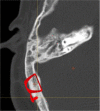Bonebridge implantation for mixed hearing loss in a patient with Kabuki syndrome
- PMID: 32921775
- PMCID: PMC7717021
- DOI: 10.23750/abm.v91i3.8257
Bonebridge implantation for mixed hearing loss in a patient with Kabuki syndrome
Abstract
The high prevalence of middle ear disease with related hearing loss in Kabuki syndrome requires the diagnostic and treatment expertise of otologists. This case report describes outcomes and changes in the quality of life of a patient affected by Kabuki syndrome with a history of recalcitrant chronic otitis media and mixed hearing loss who had undergone several unsuccessful surgical procedures before solving his problems by means of subtotal petrosectomy and active middle ear implant.
Conflict of interest statement
Each author declares that he or she has no commercial associations (e.g. consultancies, stock ownership, equity interest, patent/licensing arrangement etc.) that might pose a conflict of interest in connection with the submitted article
Figures
Similar articles
-
[One novel pathologic variation in KMT2D cause Kabuki syndrome with hearing loss as the main phenotype and related research on types of deafness].Lin Chuang Er Bi Yan Hou Tou Jing Wai Ke Za Zhi. 2019 Sep;33(9):820-824. doi: 10.13201/j.issn.1001-1781.2019.09.006. Lin Chuang Er Bi Yan Hou Tou Jing Wai Ke Za Zhi. 2019. PMID: 31446696 Review. Chinese.
-
KMT2D Deficiency Causes Sensorineural Hearing Loss in Mice and Humans.Genes (Basel). 2023 Dec 28;15(1):48. doi: 10.3390/genes15010048. Genes (Basel). 2023. PMID: 38254937 Free PMC article.
-
Caregiver-reported clinical characteristics and the burden associated with Kabuki syndrome.Am J Med Genet A. 2020 Jul;182(7):1592-1600. doi: 10.1002/ajmg.a.61584. Epub 2020 Apr 4. Am J Med Genet A. 2020. PMID: 32246746 Free PMC article.
-
Cochlear Implantation in a Patient with Kabuki Syndrome.J Int Adv Otol. 2016 Apr;12(1):129-31. doi: 10.5152/iao.2016.2004. J Int Adv Otol. 2016. PMID: 27341000
-
Vibroplasty for mixed and conductive hearing loss.Otol Neurotol. 2013 Aug;34(6):1005-12. doi: 10.1097/MAO.0b013e3182990d2b. Otol Neurotol. 2013. PMID: 23820796 Review.
Cited by
-
Kabuki Syndrome-Clinical Review with Molecular Aspects.Genes (Basel). 2021 Mar 25;12(4):468. doi: 10.3390/genes12040468. Genes (Basel). 2021. PMID: 33805950 Free PMC article. Review.
-
Neuroimaging in Kabuki syndrome and another KMT2D-related disorder.Am J Med Genet A. 2021 Dec;185(12):3770-3783. doi: 10.1002/ajmg.a.62450. Epub 2021 Aug 9. Am J Med Genet A. 2021. PMID: 34369642 Free PMC article.
-
Multicentric study on surgical information and early safety and performance results with the Bonebridge BCI 602: an active transcutaneous bone conduction hearing implant.Eur Arch Otorhinolaryngol. 2023 Apr;280(4):1565-1579. doi: 10.1007/s00405-022-07792-y. Epub 2023 Jan 10. Eur Arch Otorhinolaryngol. 2023. PMID: 36625869 Free PMC article. Review.
References
-
- Lepri FR, Cocciadiferro D, Augello B, et al. Clinical and neurobehavioral features of three novel Kabuki syndrome patients with mosaic KMT2D mutations and review of literatrure. Int J Mol Sci. 2018;19 Doi: “http://dx.doi.org/10.3390/ijms19010082. ”10.3390/ijms19010082. - PMC - PubMed
-
- Peterson-Falzone SJ, Golabi M, Lalwani AK. Otolaryngologic manifestations of Kabuki syndrome. Int J Pediatr Otorhinolaryngol. 1997;38:227–36. - PubMed
-
- Vesseur A, Cillessen E, Mylanus E. Cochlear implantation in a Patient with Kabuki Syndrome. J Int Adv Otol. 2016;12:129–31. - PubMed
-
- Schrander-Stumpel CT, Spruyt L, Curfs LM, Defllor T, Schrander JJ. Kabuki syndrome: clinical data in 20 patients, literature review, and further guidelines for preventive management. Am J Med Genet A. 2005;132:234–243. - PubMed
Publication types
MeSH terms
Supplementary concepts
LinkOut - more resources
Full Text Sources




